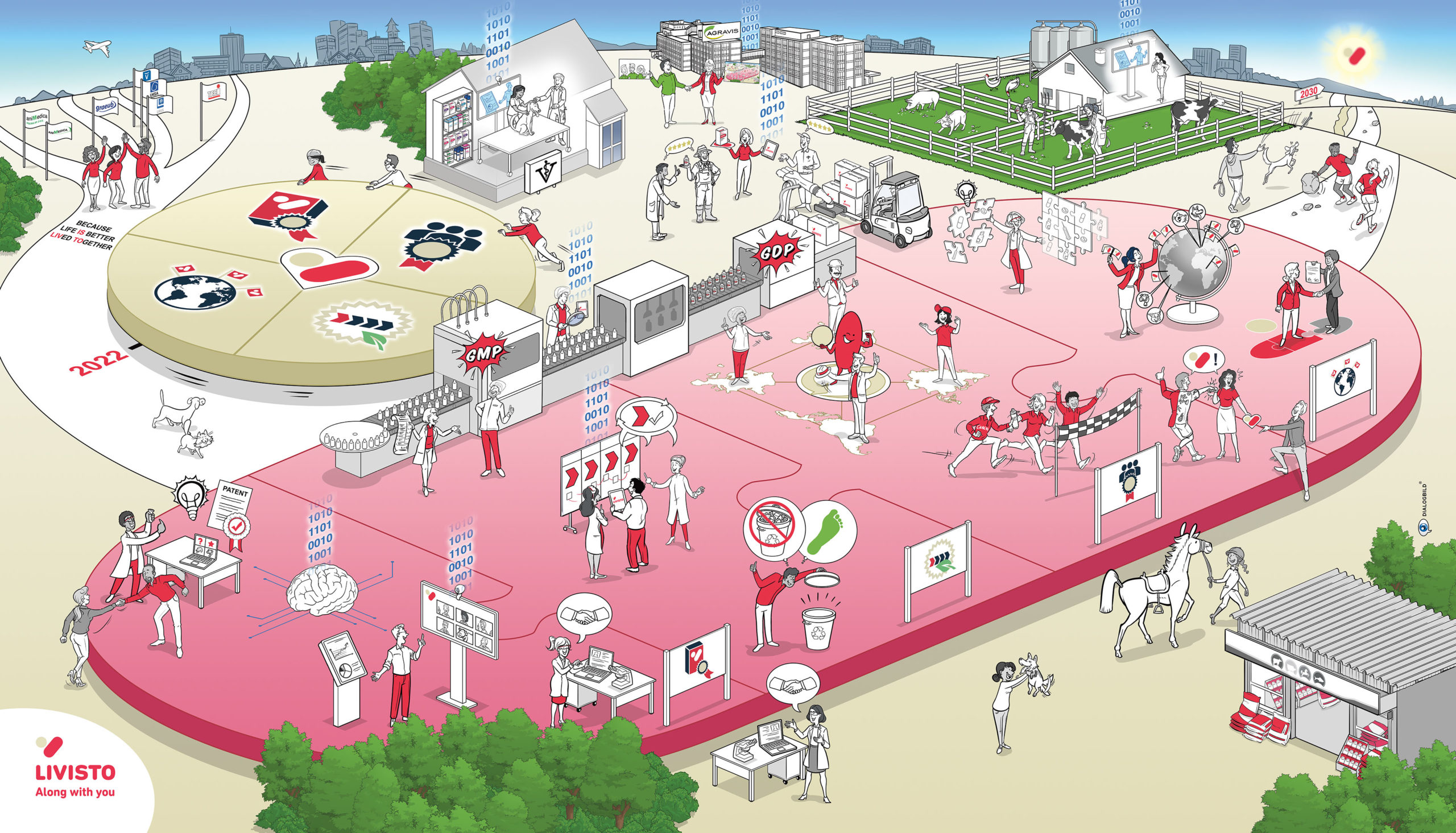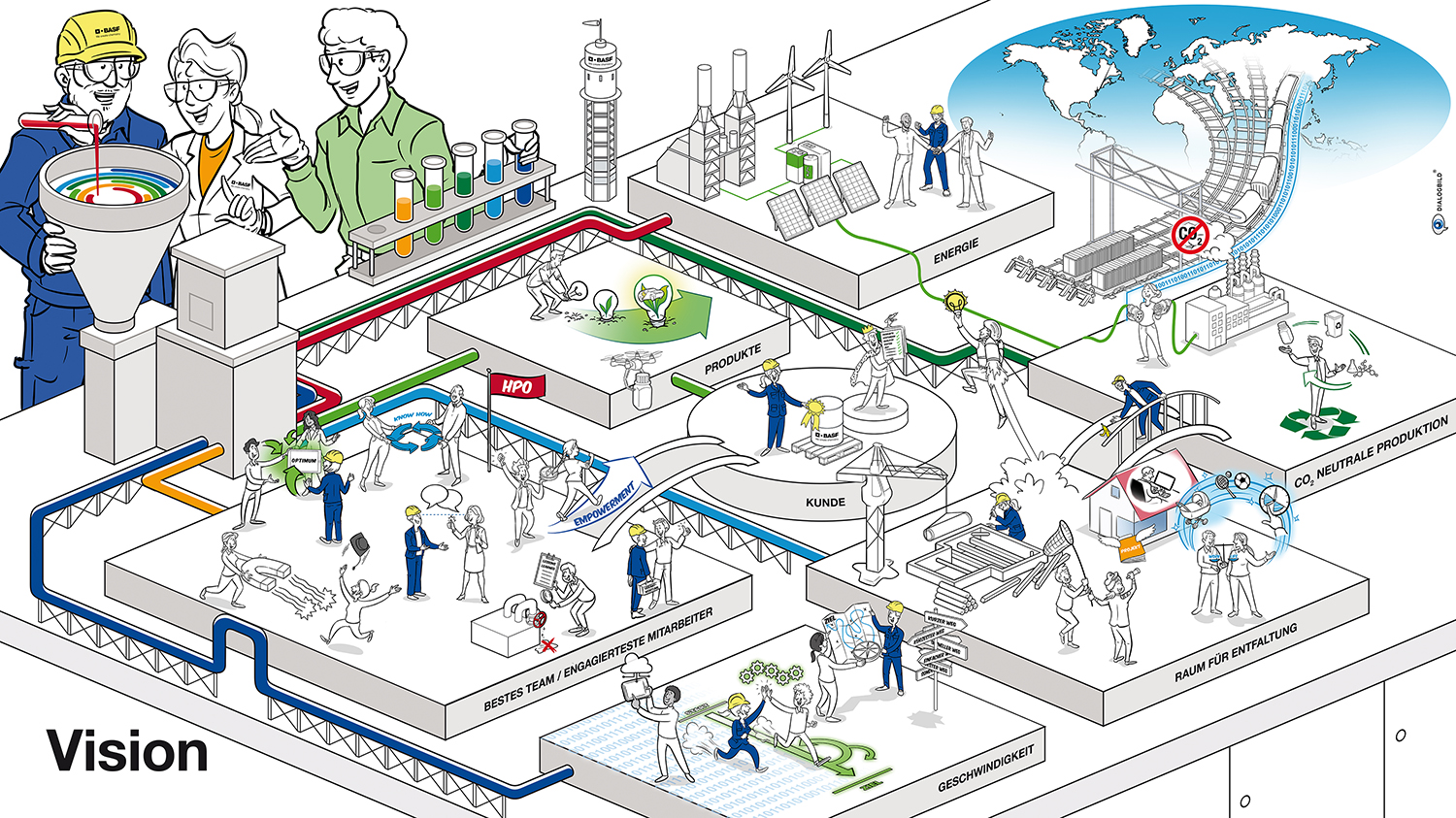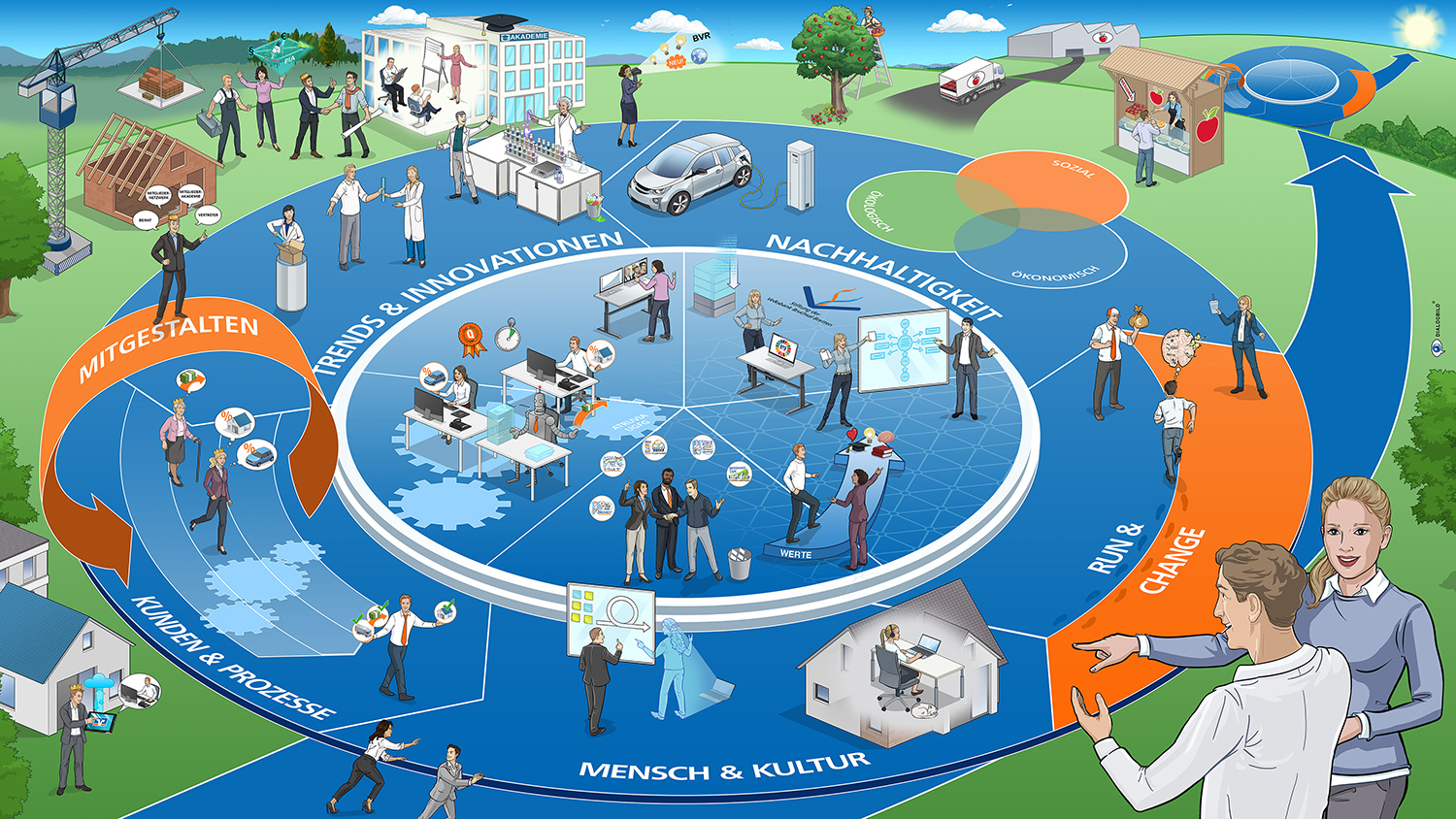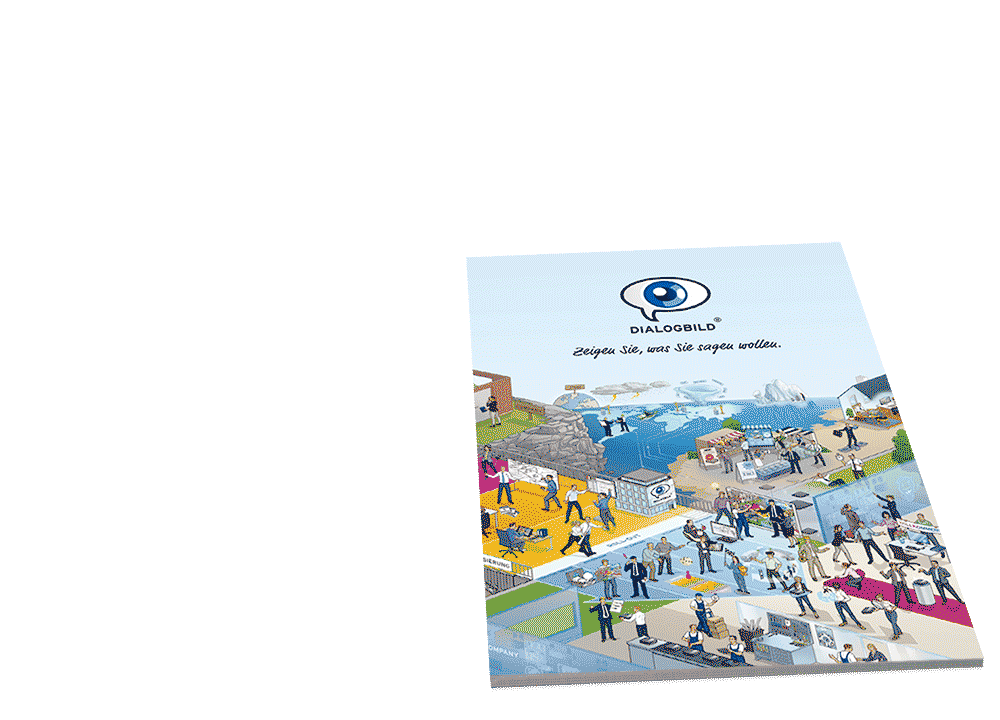







Future map: What you should know
What is a future map?
A future map is a strategic planning tool that helps companies systematically capture and visualize potential developments and future scenarios. It forms the basis for identifying future topics and megatrends that could affect the company in the coming years. This allows companies to proactively take action to seize opportunities and minimize risks.
Unlike conventional forecasts, which often focus on short-term developments, the future map focuses on long-term developments and strategic goals. It creates a visual overview of possible futures, highlights new business opportunities, and helps identify innovation potential.
The importance of megatrends and future topics
Megatrends are long-term developments that have a lasting impact on society, the economy, and technology. They often last for decades and influence various industries and markets. The most important megatrends include:
- Digitalization: The increasing networking and automation of processes.
- Climate change and sustainability: The pressure on companies to operate more sustainably and develop resource-efficient solutions.
- Demographic change: Changes in the age structure of the population that pose new challenges for the labor market and society.
- Urbanization: The trend toward urbanization and the associated infrastructure challenges.
- Technological innovation: Artificial intelligence, robotics, and other disruptive technologies that are changing existing business models.
A future map helps you identify these megatrends and assess their potential impact on your business. By visualizing future trends, you can make informed decisions and future-proof your business strategy.
Why is a future map important?
In a rapidly changing world, it's not enough to simply react to short-term market developments. Companies must be able to identify long-term trends and align their strategies accordingly. This is where the future map comes in. It offers a structured way to analyze potential developments and take targeted action.
Advantages of a future map:
- Strategic planning: The future map enables early identification of future challenges and opportunities and the integration of appropriate measures into the corporate strategy.
- Risk management: By identifying risks early on, companies can take proactive measures to protect themselves from negative impacts.
- Innovation promotion: By visualizing future topics, companies can develop new business models and tap into innovation potential.
- Clarity and transparency: A future map provides a visual and easily understandable representation of complex future scenarios, which improves internal communication and collaboration.
How do you create a map of the future?
Creating a future map requires a systematic approach. Here are the steps you should follow:
1. Identify megatrends and future themes
The first step is to identify the relevant megatrends and future themes for your company. These trends can be global, regional, or industry-specific. Research current studies and reports, such as the Future Atlas, to create a solid data foundation for your planning.
2. Develop scenarios
Once you have identified the most important trends, develop possible scenarios. These scenarios should depict various future possibilities, such as an optimistic, a pessimistic, and a neutral forecast. Each of these forecasts considers different developments in the identified megatrends.
3. Assess the impact on the company
Evaluate how the various scenarios could affect your company. What opportunities arise? What risks need to be managed? This analysis will help you set priorities and define strategic actions.
4. Visualize a future map
Visualize the identified trends and scenarios in a clear and understandable future map. This should not only depict the various developments but also clarify the connections between the individual topics. Use visual aids such as diagrams, mind maps, or process maps.
5. Derive strategic measures
Based on the future map, you derive concrete measures that will help your company prepare for the future. These measures should be anchored in your long-term strategy and regularly reviewed and adjusted.
Future map in various industries
The future map is not only relevant for large companies, but can be used in various industries and organizations. Here are some examples:
- Industry: In industry, a future map helps identify technological innovations and disruptive developments early on and align production accordingly.
- Hospitals and healthcare: In the healthcare sector, a future map can help address future challenges such as demographic change or the increasing need for digitalized processes.
- Universities and educational institutions: Educational institutions can use future maps to prepare for the increasing digitalization of teaching and changing educational requirements.
How Dialogbild can help you create a future map
Dialogbild supports companies in visualizing their strategic plans and visions of the future in a clear and understandable way. As a specialized visual communication agency, we help you make complex future topics tangible and develop your long-term strategy.
1. Customized Future Maps
We create customized future maps that are precisely tailored to your company's needs. Our visual representations help you clearly present megatrends and future topics and establish a solid foundation for your strategic planning.
2. Strategic Visualization
Our visual communication experts ensure that your future map is not only informative but also visually appealing. This allows you to effectively communicate your long-term strategy and involve your employees and stakeholders in the process.
3. Cross-Industry Expertise
Whether it's manufacturing, healthcare, or education – Dialogbild has extensive experience in visualizing future strategies across various industries. We adapt the future map to your specific requirements and help you achieve your goals.

VISION 2030
OUR MOTTO: ALONG WITH YOU - WE ARE THE ONES WITH HEART
We are the ones with heart...
... a guiding principle that drives LIVISTO and its more than 500 employees in the development and manufacture of high-quality products for the health of farm and companion animals.
Thus, they work every day to create added value for veterinarians and pet owners and, moreover, to assist them with high-quality and efficient solutions. ...

BASF Schwarzheide GmbH
BASF Schwarzheide GmbH is an industrial beacon in Lusatia and has been part of the BASF Group since 1990. More than 2,000 employees produce chemical specialties at the production site in southern Brandenburg. The product range includes polyurethane base products and systems, crop protection agents, water-based coatings, engineering plastics, foams, dispersions, laromers and, from 2022, battery materials. The site is growing and has set itself the goal of CO2-neutral production in the future and piloting the integration of renewable energies. ...

MISSION STATEMENT: VISION & VALUES
COURAGE, SUSTAINABILITY, HONESTY, PRIDE AND ENTREPRENEURSHIP
How do we manage to deliver our vision and strategy to our employees, to bring everyone to a common understanding and to embed them into the (future) work to ensure that our bank is aligned as stable, successful and future-proof? How do we manage to deliver the path of our vision and strategy with the same content into our house, without losing important integral facts, or rather, to create room for interpretation through a new choice of words? These questions gave us the idea to translate our formulated vision and strategy into a picture-based language, true to the adage: “a picture says more than 1,000 words.”
Frequently asked questions
What is a future map?
A future map is a strategic planning tool that helps companies identify long-term trends, so-called megatrends, and potential developments. It visually depicts future scenarios and helps identify opportunities and risks early on to plan strategic actions.
Why is a future map important?
A future map is important because it helps companies prepare for long-term developments. It provides a visual overview of possible futures, highlights strategic options, and helps make informed decisions. With a future map, companies can better manage risks and identify innovation potential.
What are the benefits of a future map?
- Clarity and transparency: It provides a visual representation of complex future scenarios and trends.
- Strategic planning: It enables sound, long-term planning and adaptation to future developments.
- Early risk detection: Potential threats or risks become visible early on, allowing proactive measures to be taken.
- Promoting innovation: Companies identify new business areas and innovation potential.
- Improved internal communication: The visual representation of complex topics helps employees and stakeholders better understand the company's long-term goals.
What role do megatrends play in a future map?
Megatrends are long-term, global developments that have a lasting impact on society, the economy, and technology. Examples of megatrends include digitalization, sustainability, climate change, and demographic change. A future map visualizes these megatrends and places them in the context of the company to analyze their potential impact.
How do you create a future map?
Creating a future map involves several steps:
- Identify megatrends: Determine the long-term trends that will impact your business.
- Develop scenarios: Create various future scenarios based on the trends (e.g., optimistic, pessimistic, or neutral forecasts).
- Assess impacts: Analyze the potential impact of the scenarios on your business.
- Visualization: Create a graphical representation that shows the different scenarios and their connections.
- Derive strategic actions: Define concrete steps to prepare for the future and capitalize on opportunities.
In which industries can a future map be used?
A future map can be used in almost all industries to plan for future developments. Here are some examples:
- Industry: To identify technological innovations and disruptive developments early on.
- Healthcare: To respond to demographic change and increasing demands on healthcare.
- Education and universities: To prepare for the increasing digitalization of teaching and changing requirements for educational institutions.
What is the difference between a future map and a forecast?
A forecast usually aims to predict short-term developments, while a future map offers long-term planning and strategic direction. The future map considers various scenarios and develops strategic recommendations based on these scenarios.
What is a future atlas and how does it relate to a future map?
A future atlas is a comprehensive collection of data and analyses on the economic, demographic, and technological prospects of a region or country. It provides valuable information about future developments. A future map can use the insights of a future atlas to derive specific strategic planning for a company.
How can Dialogbild help with the creation of a future map?
Dialogbild offers specialized services for the creation of future maps. We support companies in identifying relevant trends, visualizing future topics, and strategic planning. Our services include:
- Individual future maps: Customized visualizations tailored to the specific needs of your company.
- Strategic visualization: We create visually appealing representations that facilitate internal communication and support strategic measures.
- Cross-sector expertise: Whether manufacturing, healthcare, or education – we develop future maps tailored to the respective industry-specific challenges.
How often should a future map be updated?
A future map should be reviewed and updated regularly to ensure it reflects current developments. The frequency depends on the dynamics of the markets and technologies. In fast-moving industries, it is advisable to update the future map annually to be able to respond to new trends and megatrends.
 SELECT INFO PACKAGE
SELECT INFO PACKAGE